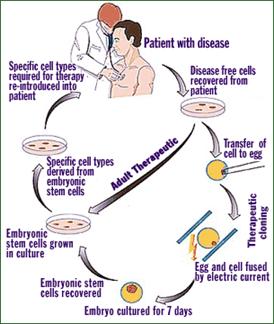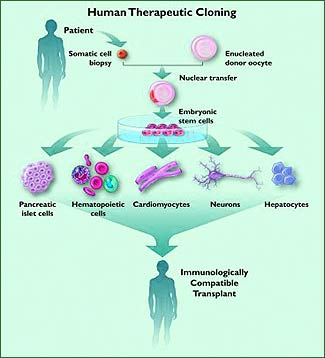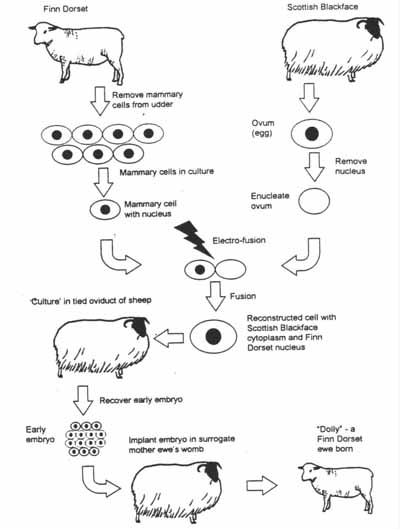Cloning-Human Cloning
Imagine having a copy of yourself, such as having an identical twin, an exact replica of you that is created from your body cells. This idea created the door for cloning.
WHAT IS CLONING generally speaking? It is done by replicating a certain type of cells or certain part of the cell/ DNA from a "parent" cell to propagate a certain desirable genetic trait.
To understand this subject we have to differentiate between its different types:
1. DNA cloning
2. Therapeutic cloning
3. Reproductive cloning
DNA CLONING
This means transferring a fragment of DNA you are interested in from one organism to a self-replicating genetic element such as bacterial plasmid so the DNA of interest can then be propagated in foreign host cells.
THERAPEUTIC CLONING
Also called "embryo cloning", it is a production of human embryos for use in research, for example, extracting stem cells from these embryos for study & for producing tissues to treat diseases.


Reproductive cloning:
A technology used to generate an animal that has the same nuclear DNA as another animal, so that every single gene is exactly the same between the two in a process called "Somatic Cell Nuclear Transfer", or (SCNT), and this type of cloning is our subject to discuss.
HISTORICAL VIEW
Scientists have been cloning animals for many years. The first trial of cloning done on animals was in 1952, a tadpole. That was earlier than the creation of Dolly the sheep in 1997 by a Scottish scientist at Rosaline Institute, the first cloning of an adult animal cell that resulted in a live mammal. Clones were created from embryonic cells. Since then researchers have cloned a number of large and small animals, including sheep, cows, mice, goats, pigs, cats, and a gaur, which makes it possible for human cloning.
How is cloning done? How does one go about making an exact genetic copy of an organism? It can be done by different ways: somatic cell nuclear transfer and artificial embryo twinning. What is the difference between these processes?
Artificial Embryo Twinning
1. Artificial embryo twinning is the relatively low-tech version of cloning. This technology is just like the natural process of creating identical twins.
In nature, twins occur just after fertilization of an egg, and rarely, if the fertilized egg "zygote", tries to divide into a two-celled embryo, then the two cells separate completely. Each one then continues to divide separately, finally developing into a separate individual inside the mother. Since they came from the same zygote, the developing individuals will be genetically identical twins.
Artificial embryo twinning is produced in the same way, but instead of the mother's uterus, it occurs in a Petri dish. This is accomplished by manually separating a very early embryo into separate cells, then allowing each cell to divide on its own. The resulting embryos are placed into a surrogate mother, until term is complete and the baby is delivered. All the embryos came from the same zygote, so they are genetically identical.
2. Somatic Cell Nuclear Transfer
Somatic cell nuclear transfer (SCNT) uses a different approach than artificial embryo twinning, with the same result: an exact clone of an individual. Dolly the sheep was created by this method.
To make Dolly, researchers isolated a somatic cell from an adult female sheep. Then the nucleus is transferred from that cell to an egg cell after removing the nucleus. Followed by chemical reactions and interventions, the egg cell, with the new nucleus, behaves like a freshly fertilized zygote. An embryo then develops, is implanted into a surrogate mother, and carried to term.
The lamb, Dolly, was an exact genetic replica of the adult female sheep who donated the somatic cell nucleus to the enucleated egg, resulting in the first mammal to be cloned from an adult somatic cell.
What is the difference between the natural way of making an embryo and SCNT?
An embryo is composed of cells containing two complete sets of chromosomes. From where the two sets of chromosomes originated lies the difference between fertilization and SCNT .
In fertilization, the sperm and egg, both contain one set of chromosomes. After fertilization of the egg by a sperm, the resulting zygote ends up with two sets; one from the father (sperm) and one from the mother (egg).

In SCNT, the nucleus from a somatic cell is used to replace the egg nucleus. The egg contained the single set of chromosomes, but the somatic cell nucleus contains two complete sets of chromosomes. And the resulting embryo will have both sets of chromosomes from the somatic cell.
What are the risks of cloning?
Reproductive cloning is expensive and not highly efficient with a 90% failure rate of cloning attempts to produce a viable offspring. To produce one viable clone, more than 100 nuclear transfer procedures could be required. Cloned animals tend to have more compromised immune function and higher rates of infection, tumor growth, and other disorders in addition to low success rates. Studies done in Japan have shown that cloned mice live in poor health and die early. One-third of the cloned calves born alive have died young. Most of the others were large in an abnormal way. Most animals that were cloned have not lived long enough to generate good data about how clones age. Unfortunately, being healthy at a young age is not a good indicator of survival in the long term. Clones have been known to die without identifiable cause. For example, Australia's first cloned sheep was healthy on the day she died, and the autopsy failed to determine a cause of death.
Should humans be cloned? 
Due to the inefficiency of animal cloning (only about one or two viable offspring for every 100 experiments) and the lack of understanding about reproductive cloning, scientists believe that it would be unethical to attempt human cloning. Most attempts to clone mammals fail. Also about 30% of clones born alive are affected by "large offspring syndrome" and other serious conditions. Most cloned animals have died early from infections and other complications. Human cloning will likely have the same problems. In addition, the impact of cloning on mental development is not known. Intellect and mood may not be as important for a cow or a mouse, but they are crucial for the development of humans. Many unknowns exist concerning reproductive cloning, so the attempt to clone humans at this time is considered potentially dangerous and ethically irresponsible.
Reproductive semi-cloning respecting biparental embryo origin
Embryos might result from syngamy between a gamete nucleus and a haploidized somatic cell nucleus, and the somatic cell may replace either the male or the female gamete, a potentially applicable technique in the treatment of both male and female infertility. There is a controversy about haploidization and it will require more research. Though sharing some features with conventional cloning, the technique is biologically closer to normal fertilization because the future individual results from the union of two parental genomes of which one is actually brought by a gamete. This would alleviate some of the ethical concerns raised against the use of conventional cloning in human assisted-reproduction.
Dr Najeeb Layyous F.R.C.O.G
Consultant Obstetrician, Gynecologist and Infertility Specialist







 Pregnancy Due Date Calculator
Pregnancy Due Date Calculator
 Chinese Gender Predictor
Chinese Gender Predictor
 Ovulation Calculator
Ovulation Calculator
 IVF Due Date Calculator
IVF Due Date Calculator
